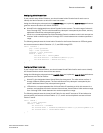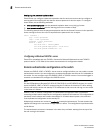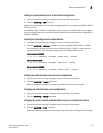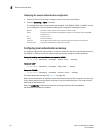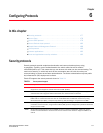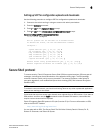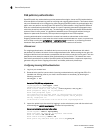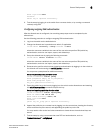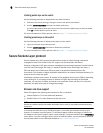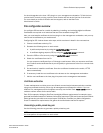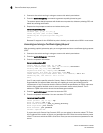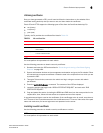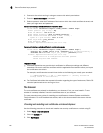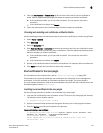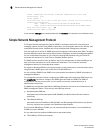Fabric OS Administrator’s Guide 181
53-1002745-02
Secure Shell protocol
6
Enter login name:auser
Password:
Public key is imported successfully.
4. Test the setup by logging in to the switch from a remote device, or by running a command
remotely using SSH.
Configuring outgoing SSH authentication
After the allowed-user is configured, the remaining setup steps must be completed by the
allowed-user.
Use the following procedure to configure outgoing SSH authentication:
1. Log in to the switch as the default admin.
2. Change the allowed-user’s permissions to admin, if applicable.
switch:admin> userconfig --change username -r admin
where the username variable is the name of the user who can perform SSH public key
authentication, and who can import, export, and delete keys.
3. Set up the allowed-user by typing the following command:
switch:admin> sshutil allowuser username
where the username variable is the name of the user who can perform SSH public key
authentication, and who can import, export, and delete keys.
4. Generate a key pair for switch-to-host (outgoing) authentication by logging in to the switch as
the allowed user and entering the sshUtil genkey command.
You may enter a passphrase for additional security.
Example of generating a key pair on the switch
switch:alloweduser> sshutil genkey
Enter passphrase (empty for no passphrase):
Enter same passphrase again:
Key pair generated successfully.
5. Export the public key to the host by logging in to the switch as the allowed-user and entering
the sshUtil exportpubkey command to export the key.
Example of exporting a public key from the switch
switch:alloweduser> sshutil exportpubkey
Enter IP address:192.168.38.244
Enter remote directory:~auser/.ssh
Enter login name:auser
Password:
public key out_going.pub is exported successfully.
6. Append the public key to a remote host by logging in to the remote host, locating the directory
where authorized keys are stored, and appending the public key to the file.
You may need to refer to the host’s documentation to locate where the authorized keys are
stored.
7. Test the setup by using a command that uses SCP and authentication, such as
firmwareDownload or configUpload.



